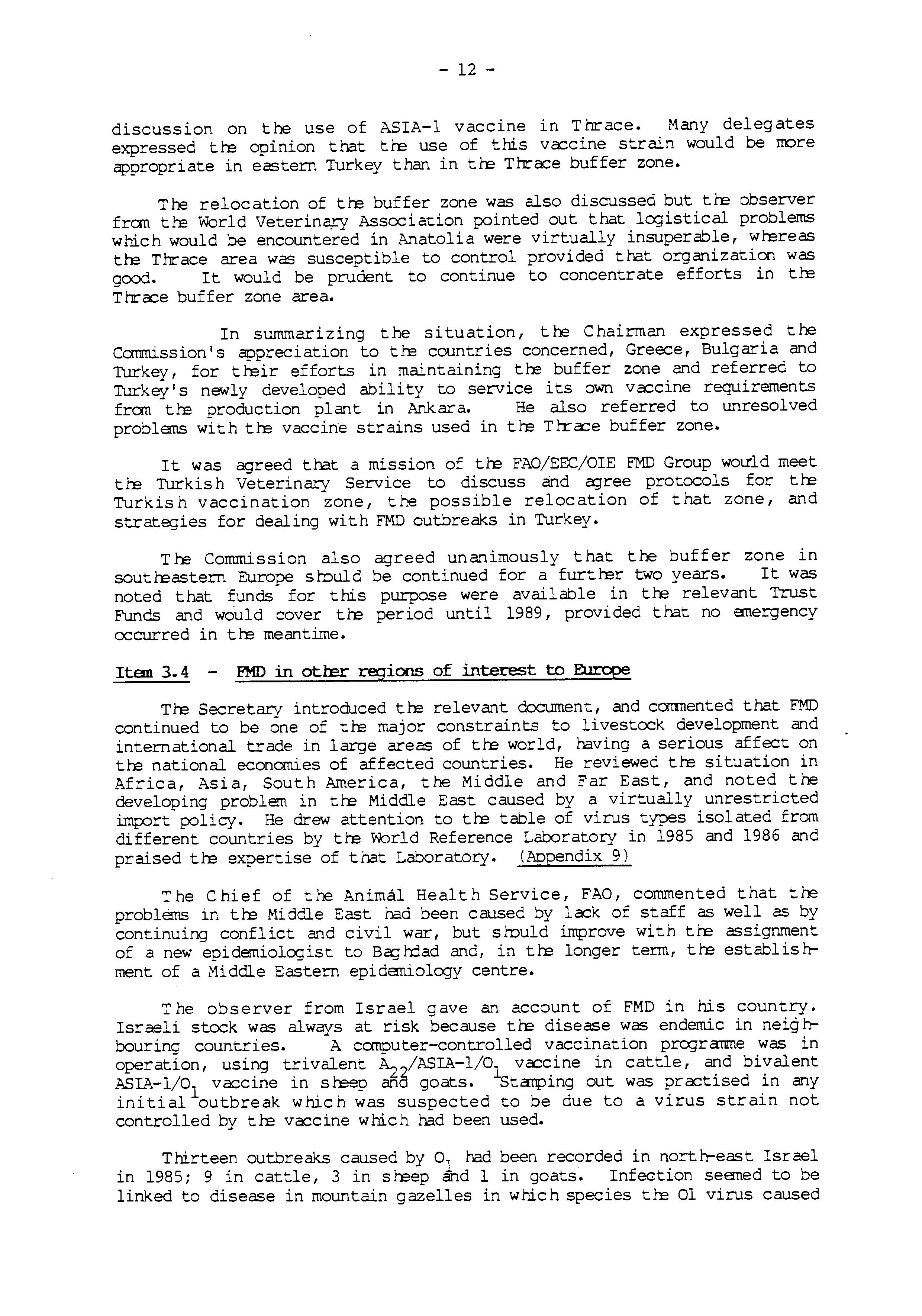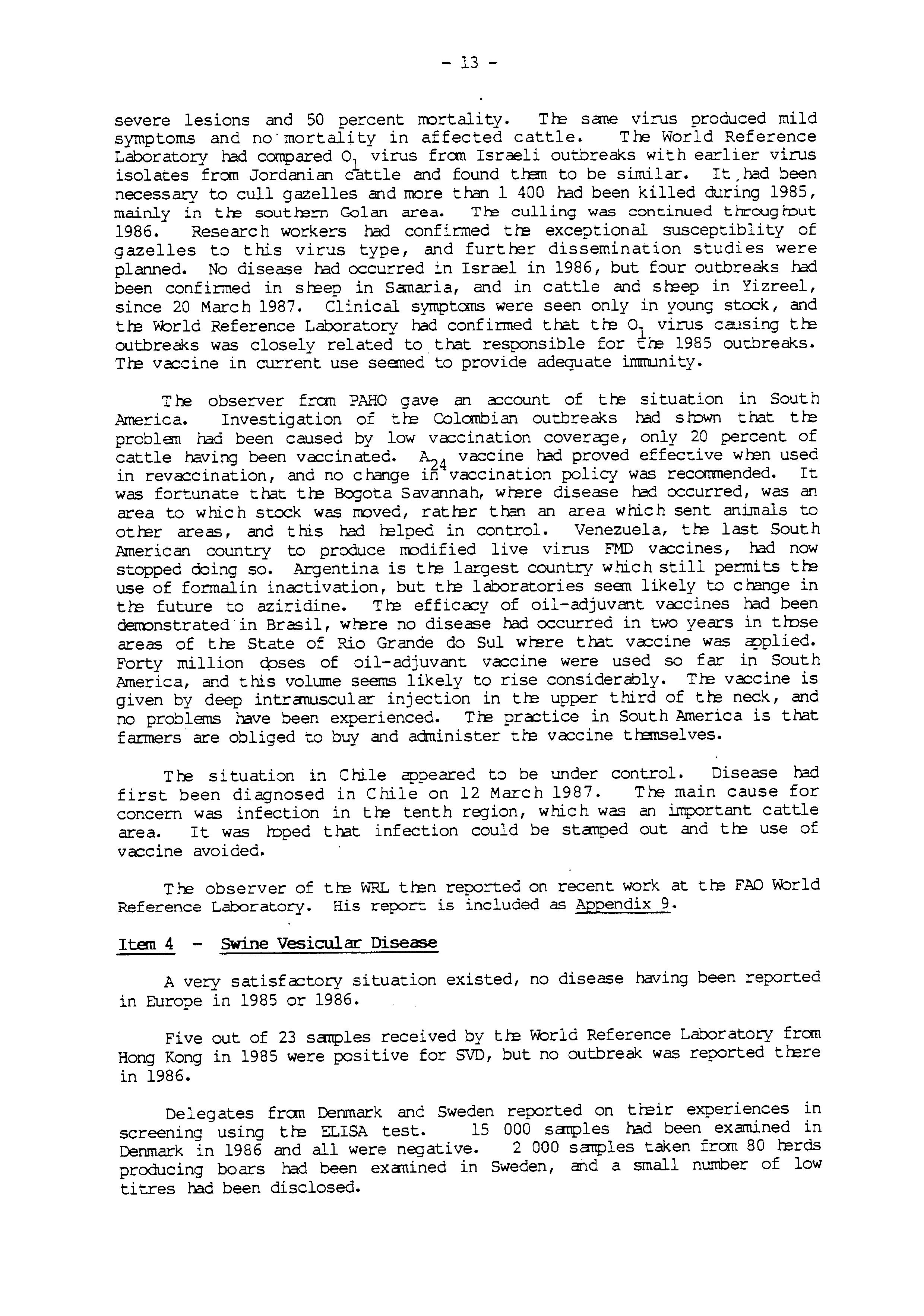
5 minute read
Appendix
discussion on the use of ASIA-1 vaccine in Thrace. Many delegates expressed the opinion that the use of this va:::cine strain would be rrore appropriate in eastern Turkey than in the Thr'a:::e buffer zone.
The relocation of the buffer zone was also discussed but the observer fran the World Veterina,..ry Associacion pointed out that logistical problems which would be encountered in Anatolia were virtually insuperable, whereas the Thr'ace area was susceptible to control provided that o:::-ganization was good. It would be prudent to continue to concentrate efforts in the Thr'a:::e buffer zone area.
Advertisement
In summarizing the situation, the Chairman expressed the Carmi.ssion 1 s appreciation to the countries concerned, Greece, Bulgaria and Turkey, for their efforts in maintaining the buffer zone and referred to Turkey's newly developed ability to service its own va:::cine requirements fran the production plant in Ankara. He also referred to unresolved problems with the vaccine strains used in the Ttra:::e buffer zone.
It was agreed that a mission of tre FAO/EEC/OIE FMD Group woLrld meet tre Turkish Veterinary Service to discuss and c:gree protocols for the Turkish vaccination zone, the possible relocation of that zone, and strategies for dealing with FMD outbreaks in Turkey.
The Commission also agreed unanimously that the buffer zone in southeastern Europe smuld be continued for a further two years. It was noted that funds for this purpose were available in the relevant Trust Funds and would cover the period until 1989, provided that no emergency occurred in the meantime.
Item 3.4 FMD in otlEr regions of interest to Europe
The Secretary introduced the relevant document, and ccmnented that FMD continued to be one of t.he major constraints to livestock development and international trade in large areas of the world, having a serious affect on the national econanies of affected countries. He reviewed the situation in Africa, Asia, South America, the Middle and Far East, and noted the developing problem in the Middle East caused by a virtually unrestricted import policy. He drew attention to the table of virus types isolated from different countries by the World Reference Laboratory in 1985 and 1986 and praised the expertise of that Laboratory. (Aooendix 9)
':'he Chief of the Animal Health Service, FAO, commented that t.he problems in the Middle East had been caused by la:::k of staff as well as by continuing conflict and civil war, but smuld improve with tre assignment of a new epidemiologist to Ba;; mad and, in tre longer term, the establislr ment of a Middle Eastern epidemiology centre.
'I' he observer from Israel gave an account of FMD in his country. Israeli stock was always at risk because tte disease was endemic in neig lr bouring countries. A computer-controlled vaccination progranme was in operation, using trivalent ~ 2/ASIA-1/0L va:::cine in cattle, and bivalent ASIA-1/01 vaccine in sheep ana goats. -Stanping out was pra:::tised in any initial outbreak which was suspected to be due to a virus strain not controlled by tte va:::cine which rad been used.
Thirteen outbreaks caused by o, rad been recorded in nortlreast Israel in 1985; 9 in cattle, 3 in sheep ahd 1 in goats. Infec;:tion seemed to be linked to disease in mountain gazelles in which species the 01 virus caused
severe lesions and 50 percent rrortality. Tl::e sane virus produced mild symptoms and no·mortaiity in affected cattle. The World Reference ~aboratory had cornp~ed isolates fran Jordanian o1 virus fran Israeli outbreak~ ':"ith cattle and found trern to be s1IDilar. earlier virus It, had been necessary to cull gazelles and more than 1 400 had been killed during 1985,
mainly in the southern Golan area. The culling was continued tirougl-Dut 1986. Research workers had confirmed tre exceptional susceptiblity of gazelles to this virus type, and further dissemination studies were planned. No disease had occurred in Israel in 1986, but four outbreaks had been confirmed in steep in Samaria, and in cattle and steep in Yizreel, since 20 March 1987. Clinical syrnptans were seen only in young stock, and tte World Reference Laboratory had confirmed that tte O virus causing tte outbreaks was closely related to that responsible for tre 1985 outbreaks. Tte vaccine in current use seemed to provide adequate irmru.nity.
The observer fran PAHO gave an c.ecount of tre situation in South America. Investigation of tre Colanbian outbreaks had srown that tl::e problem had been caused by low vc.ecination covera;ie, only 20 percent of cattle having been vaccinated. in revaccination, and no change ~ 4 vaccine had proved effect.ive wren used in vaccination policy was reccmnended. It was fortunate that tl":e Bcgota Savannah, wrere disease had occurred, was an area to which stock was moved, ratter than an area which sent animals to otter areas, and this had relped in control. Venezuela, tte last South .American country to produce rrodified live virus FMD vaccines, had now stopped doing so. Argentina is tte largest country which still permits tl::e use of formalin inactivation, but tte laboratories seem likely to change in tl::e future to aziridine. Tl":e efficacy of oil-adjuvant vaccines had been derronstrated in Brasil, wrere no disease had occurred in two years in trose areas of tte State of Rio Grande do Sul wl::ere that va::cine was applied. Forty million dpses of oil-adjuvant vaccine were used so far in South .America, and this volume seems likely to rise considerably. Tl::e vaccine is given by deep intranuscular injection in tte upper third of tte neck, and no problems have been experienced. Tl":e practice in South .America is that farmers are obliged to buy and administer tl::e vaccine t.tanselves.

The situation in Chi.le appeared to be under control. Disease had first been diagnosed in Chile on 12 March 1987. The main cause for concern was infection in tl":e tenth region, which was an important cattle area. It was roped that infection could be sta:nped out and tl":e use of vaccine avoided.
The observer of tl::e WRL tr.en repo::::ted on recent work at tre E'AO World
Reference Laboratory. His repor~ is included as Appendix 9.
Item 4 - Swine Vesicular Disease
A very satisfc.etory situation existed, no disease having been reported in Europe in 1985 or 1986.
Five out of 23 sanples received by tte World Reference Laboratory fran Hong Kong in 1985 were positive for SVD, but no outbreak was reported tl::ere in 1986.
Delegates fran Denmark and Sweden reported on treir experiences in screening using tl::e ELISA test. 15 000 sanples had been examined in Denmark in 1986 and all were negative. 2 000 sanples taken fran 80 terds producing boars had been exanined in Sweden, and a small number of low titres had been disclosed.










